A Good Weekend For Aurora Watchers?
Note: If you are using Microsoft MediaPlayer to view the MPEG movies, you should try looking at both the small and large versions, since some frames may be dropped when playing the large version.
| Click on the images for larger versions | |
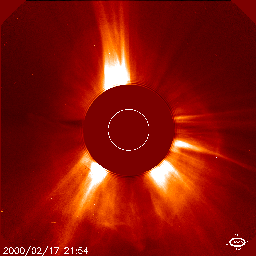
LASCO C2 Coronagraph Image of CME. MPEG Movies: 512x512, 256x256 |
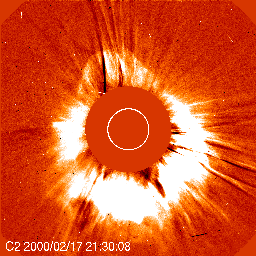
LASCO C2 Difference Image of CME MPEG Movies: 512x512 256x256 |
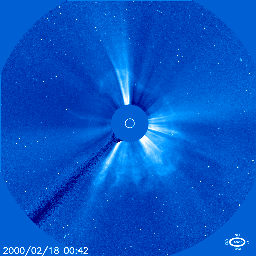
LASCO C3 Coronagraph Image of CME MPEG Movies: 512x512 256x256 QuickTime: Small, Large |
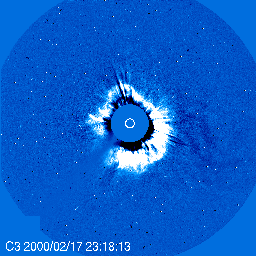
LASCO C3 Difference Image of CME MPEG Movies: 512x512 256x256 |
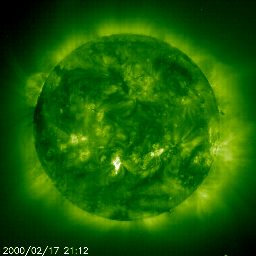
EIT Image of flaring region MPEG Movies: 512x512 (3.3Mb), 256x256 (1.1Mb) QuickTime: Small, Large |
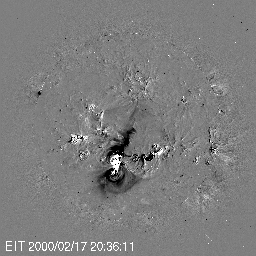
EIT Difference image MPEG Movies: 512x512, 256x256 QuickTime |
Explanatory note:The images (and movies) on the right are so-called "running difference" images, showing the difference in brightness from one observation to another. This brings out more contrast, highlighting the coronal mass ejections, but also introduces some artifacts. Most notably, most of the dark areas are not really "dark", they have just dimmed since the last image (or a bright spot may have moved from one place to another).
Caption: At 21:30 UT on 17 February the ESA-NASA SOHO spacecraft spotted a large puff of gas from the Sun. Subsequent images from the LASCO coronagraph on SOHO confirmed that this coronal mass ejection is heading towards the Earth. The gas will reach the Earth's vicinity on Saturday or Sunday, 19 or 20 February. When it hits the Earth's magnetic shield, it is likely to cause a magnetic storm. It may provoke spectacular displays of auroras high in the air over sub-polar regions of the Earth, and perhaps even at lower latitudes in Scandinavia and North America.
In a second event, at about 10:00 UT on 18 February SOHO and other spacecraft registered a burst of energetic particles --- solar protons -- coming from an eruption on the Sun. They may be associated with a second large mass ejection seen by LASCO, which is not heading for the Earth.
The proton shower is detected by the EIT instrument as increased noise due to particle hits on their detector. The plot below shows the increase in the noise levels caused by this event (click on image for a larger version).
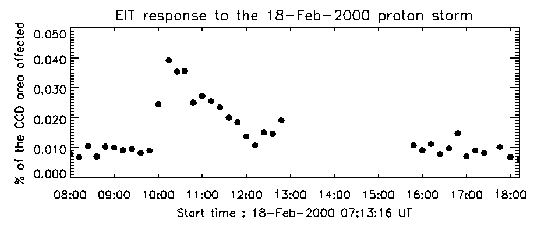
Satellite controllers will be on the alert this weekend for harmful effects that the earthward-bound mass ejection may have on their spacecraft. Users of telecommunications and navigation satellites may be affected too, as may operators of ground systems that are vulnerable to the effects of solar storms, such as power transmission lines.
Most mass ejections from the Sun miss the Earth, or are minor events. When a large mass ejection is heading towards the Earth it appears as an expanding bright halo around the Sun, in SOHO/LASCO images. A mass ejection heading directly away from the Earth, on the far side of the Sun, has a similar appearance. But in this case the EIT telescope on SOHO saw shock waves in the solar atmosphere associated with the mass ejection, making it certainly an Earth-approaching event.
Half an hour or so before the mass ejection reaches the Earth, it will wash over SOHO itself, and the CELIAS solar-wind instrument on the spacecraft will gauge the density of the gas. Only then will scientists and engineers know how hard the Earth?s space environment will be hit.
Instruments: LASCO (Large Angle and Spectrometric Coronagraph); EIT (Extreme ultraviolet Imaging Telescope)
Taken: 17 February 2000 - 18 February 2000
Credits to:Kevin Schenck, Frederic Auchere, Joe Gurman, Steele Hill,
Stein Vidar Haugan.


